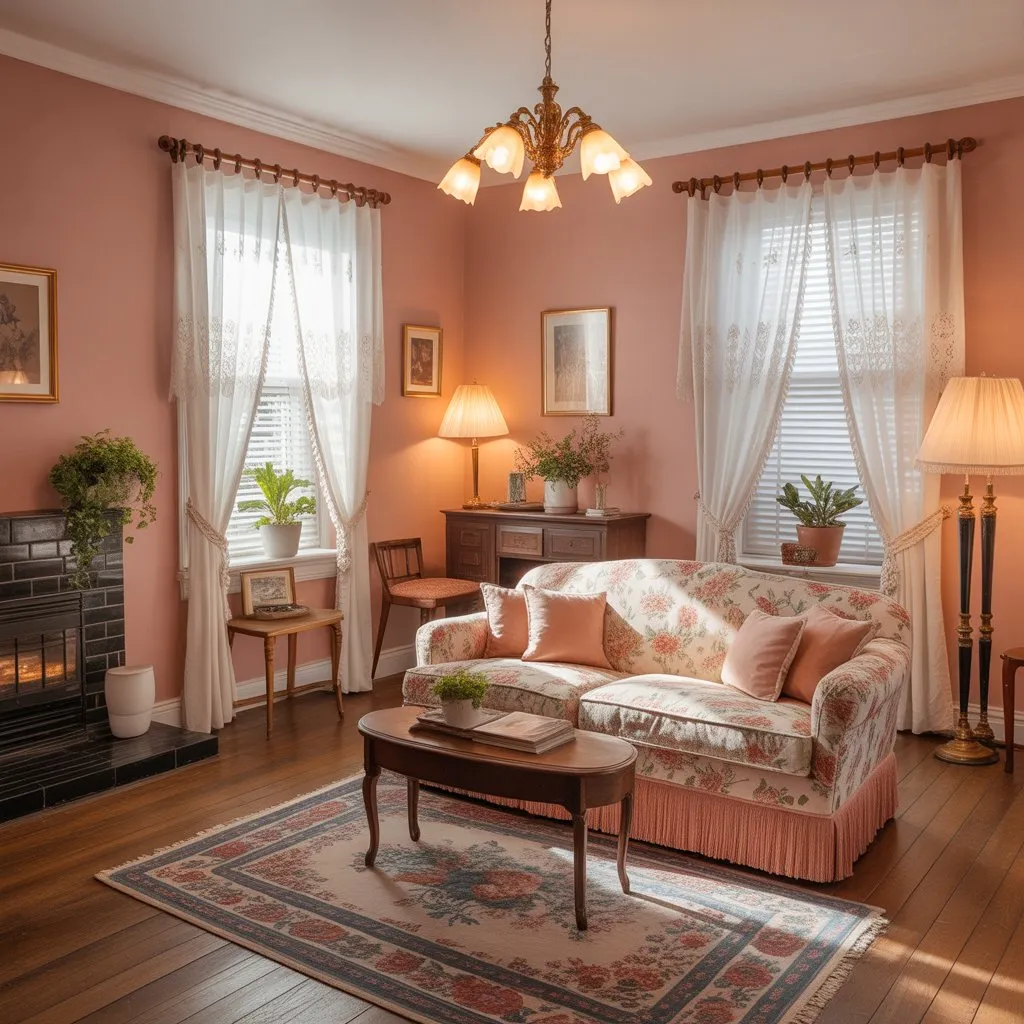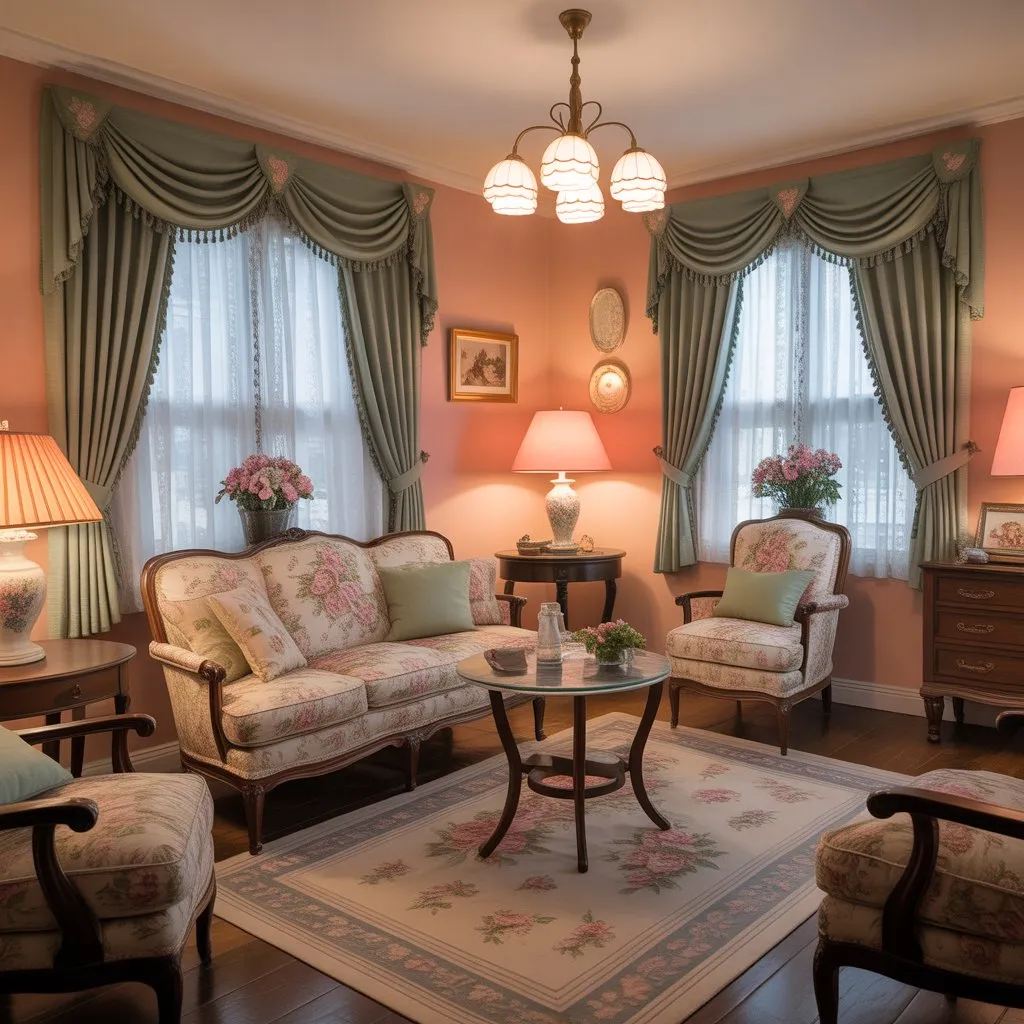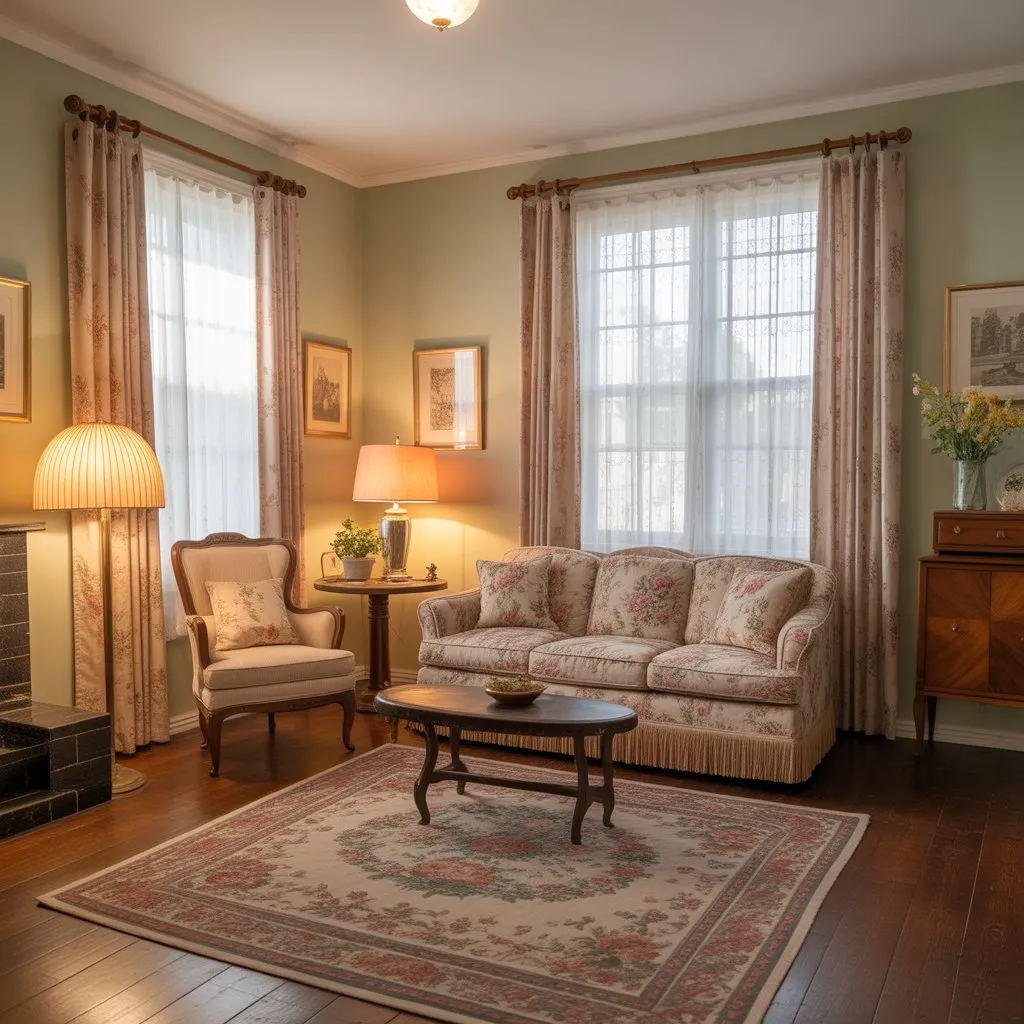Our Location
304 North Cardinal St.
Dorchester Center, MA 02124

The 1940s interior design era remains one of the most fascinating and emotionally rich periods in design history. Born in the shadow of World War II and shaped by both austerity and post-war optimism, this decade redefined how people decorated their homes. What makes 1940s interior design so captivating even today is its balance — a graceful mix of practicality, comfort, and understated beauty.
During this time, people learned to create cozy, functional spaces with limited resources while still expressing creativity. Many homes reflected hope, resourcefulness, and an emerging modern sensibility that bridged the classic elegance of the 1930s with the bold innovations of the 1950s.
In this article, we’ll explore every aspect of 1940s interior design — from furniture and materials to color palettes, lighting, and architectural influences — and how you can bring this nostalgic charm into your modern home.
At its heart, 1940s interior design tells a story of resilience and transition. The early part of the decade was marked by wartime scarcity, forcing homeowners to embrace simplicity. Decorative items were reused, fabrics were repurposed, and modesty became a design principle.
However, as the war ended and prosperity began to return, homes started to fill with optimism and warmth. The latter half of the 1940s introduced softer curves, lighter colors, and a revived interest in elegance. The American dream home began to take shape — practical, welcoming, and stylish in an understated way.
This balance of simplicity and refinement is what continues to make 1940s interior design so appealing to homeowners and designers today.

Color played a crucial role in defining the mood of the 1940s interior design era. Early-war homes often featured muted, earthy tones — think beiges, grays, browns, and deep greens — reflecting both resource limitations and the somber atmosphere of wartime life.
But after 1945, colors became brighter and more cheerful. Homeowners embraced hues that symbolized optimism and peace. Pastel shades like soft mint, sky blue, butter yellow, and rose pink became popular, especially in kitchens and bedrooms.
Walls were often painted in creamy neutrals, allowing furniture and accessories to stand out. In kitchens and bathrooms, tiles in pale aqua, jade green, or sunny yellow became favorites. These tones brought a sense of lightness and hope, perfectly capturing the post-war spirit of renewal.
Today, using this palette is one of the easiest ways to bring 1940s interior design into a modern setting. Combine soft neutrals with cheerful pastels, and you’ll instantly evoke that nostalgic charm.

Furniture in 1940s interior design was influenced heavily by practicality and comfort. Early in the decade, manufacturers had to work with limited materials due to wartime restrictions. Metal was reserved for the war effort, so wood became the dominant choice for furniture.
Designs were sturdy and functional, with minimal ornamentation. Straight lines, rounded edges, and solid craftsmanship defined the style. After the war, furniture began to adopt a more decorative flair. The growing economy allowed for better materials, and designers introduced graceful curves, inlays, and new finishes.
Common furniture pieces included:
Incorporating these timeless pieces into a home today helps maintain the warmth and authenticity of 1940s interior design, especially when paired with era-appropriate fabrics and accessories.

One of the most charming aspects of 1940s interior design is the creative use of fabrics. With limited access to new textiles during the war, homemakers repurposed existing materials — old curtains became cushion covers, and leftover fabric was stitched into patchwork quilts.
After the war, the textile industry blossomed again, introducing cheerful patterns and textures. Floral prints, plaid, and chintz dominated the scene, bringing a homely and comforting atmosphere.
Cotton and linen were widely used, but rayon and early synthetics began to appear as modern innovations. Upholstery often featured cozy, tactile fabrics in soft shades. Lace curtains and crocheted doilies added a touch of femininity and warmth to living rooms and bedrooms alike.
To recreate 1940s interior design in your home today, focus on layering textures — soft upholstery, floral cushions, and draped curtains with subtle detailing. These tactile choices can instantly capture the cozy, nostalgic feeling of the decade.

Lighting played a significant role in shaping the mood of 1940s interior design. The homes of this period were designed for comfort and intimacy, and the lighting reflected that sensibility.
Ceiling fixtures were often simple and functional, featuring frosted glass or floral-shaped shades. Table lamps and floor lamps, however, became opportunities for creativity. Elegant ceramic bases, pleated fabric shades, and warm incandescent bulbs added softness and warmth.
After the war, designers began experimenting with new materials like chrome, brass, and Bakelite, which brought a hint of modernism into homes. Yet, the overall goal remained the same — to create a calm, inviting environment.
Today, using warm-toned bulbs, vintage-style lamps, and diffused lighting can help you recreate that timeless 1940s interior design glow in your modern space.
The kitchen was the heart of every home, and this was especially true in the 1940s. Wartime rationing meant that homemakers spent considerable time planning and preparing meals efficiently. This practicality influenced 1940s interior design, resulting in kitchens that were both functional and cheerful.
Built-in cabinets, tiled backsplashes, and compact layouts were typical. Materials like linoleum and enamel were popular for their durability and easy cleaning. Pastel-colored appliances and utensils — mint green mixers, soft yellow toasters — became symbols of comfort and optimism.
Dining rooms were often adjacent to the kitchen and designed for family connection. A sturdy wooden table, matching chairs, and a china cabinet displaying treasured dishware created an atmosphere of warmth and pride.
Incorporating these touches today — such as retro-inspired tiles, enamelware, or a wooden dining set — can make your space feel authentically rooted in 1940s interior design traditions.
The living room in 1940s interior design served as the central gathering space for families. Radio was the main source of entertainment, so furniture arrangements often revolved around this focal point.
Sofas were typically upholstered in floral or plaid fabric, complemented by cushioned armchairs. Wooden coffee tables, decorative lamps, and framed family photos completed the cozy aesthetic.
The post-war years brought a touch of luxury — perhaps a velvet cushion, a glass vase, or a new rug. The overall feeling was homely but polished, reflecting both comfort and quiet pride.
When designing a living room inspired by the 1940s today, prioritize balance and intimacy. Keep furniture arrangements conversational and close, use layered lighting, and choose soft, nostalgic patterns. These small details create the essence of 1940s interior design with timeless appeal.
Bedrooms in 1940s interior design reflected simplicity with a hint of romance. Painted wooden furniture, lace-trimmed curtains, and floral bedspreads created a tranquil environment.
Colors were typically soft — cream, rose, pale blue, or buttery yellow. Many homeowners decorated with matching vanity sets, mirrors, and bedside lamps. A small writing desk or sewing corner was also common, as self-sufficiency remained a strong value during this era.
Even modest bedrooms had personality. Handmade touches — embroidered linens, knitted throws, or framed photos — made the space deeply personal.
If you want to embrace 1940s interior design in your bedroom today, look for reproduction furniture or vintage-inspired bedding with gentle patterns. Pair these with warm lighting and soft textures to create a nostalgic retreat.
Bathrooms in 1940s interior design were modest but charming. Functionality ruled, yet attention was given to aesthetics through color and tile design. Common tile colors included soft green, pink, blue, and ivory, often paired with black trim for a clean, defined look.
Pedestal sinks, built-in medicine cabinets, and chrome fixtures were hallmarks of the decade. Accessories like glass jars, embroidered hand towels, and small floral arrangements added a touch of personal style.
To achieve a 1940s-inspired bathroom today, opt for retro tiling patterns, chrome details, and pastel tones. Small touches like a vintage mirror or porcelain soap dish can complete the nostalgic look beautifully.
Architecture in the 1940s had a profound impact on the overall aesthetic of the home. The war years brought an emphasis on practicality, smaller homes, and efficient floor plans. Many families relocated to suburban neighborhoods, where modest bungalows and Cape Cod–style houses became the standard.
The clean lines and balanced proportions of these homes shaped the foundation for 1940s interior design. Instead of ornate detailing, designers favored symmetry, comfort, and usability. Built-in features like shelving units, window seats, and cabinetry reflected a desire for functionality.
Windows were often large to allow natural light to flood the rooms, a symbol of optimism after dark times. Arched doorways and simple moldings were common architectural details that added subtle elegance without extravagance. Fireplaces remained the heart of the living space — a reminder of warmth, family, and togetherness.
If you’re incorporating 1940s interior design into a modern home, focus on these architectural details. Create spaces that feel connected and open, but preserve the sense of intimacy that defined this era. Subtle trims, neutral tones, and built-ins can transform even a contemporary setting into a warm, nostalgic environment.
By the late 1940s, as the war ended and prosperity returned, American homes began to evolve rapidly. The influence of industrial innovation and new materials marked a transition from purely traditional styles toward early modernism.
In this post-war period, 1940s interior design started blending practical wartime simplicity with the glamour and optimism of a new age. Metal furniture returned to the market, and plastics, laminates, and synthetic fabrics became part of the design vocabulary.
Kitchens, once utilitarian, became symbols of progress. Appliances like refrigerators, toasters, and electric ovens were proudly displayed. Homeowners embraced convenience and celebrated domestic life as part of a modern identity.
This fusion of practicality and innovation created a unique aesthetic — one that continues to inspire contemporary designers. When you integrate 1940s interior design elements today, you’re not just recreating a style; you’re reviving an era that defined the foundation of modern home living.
Accessories in 1940s interior design were all about personal expression. While early-decade homes were modest due to material shortages, creativity flourished in the details.
After 1945, decorative items became more abundant. Homeowners proudly displayed family heirlooms, vases, clocks, framed photos, and porcelain figurines. Handmade crafts, embroidery, and knitted décor reflected both tradition and individuality.
In many homes, you’d find floral prints framed in wooden or gold-toned frames, lace doilies under lamps, and patterned curtains matching upholstery. Wallpaper also made a comeback — often featuring soft florals, vines, or geometric patterns that brightened smaller rooms.
To bring this charm to your home, focus on layered décor. Add sentimental pieces, vintage accessories, or even retro radios and telephones. The goal of 1940s interior design is to create a lived-in, personal feel where every object tells a story.
The materials used in 1940s interior design reflected both the resourcefulness of the wartime era and the innovation of the post-war years. Early in the decade, natural woods like oak, pine, and maple dominated because they were accessible and easy to work with.
After the war, manufacturing advances introduced materials like Formica, Bakelite, and chrome, which became staples of modern kitchens and dining sets. Enamel finishes on appliances and pastel-painted wooden furniture reflected the transition toward brighter, more hopeful living spaces.
Floors were often covered in linoleum for practicality, though hardwood was used in living areas and bedrooms. Rugs with geometric or floral patterns provided warmth and personality.
To authentically reproduce 1940s interior design today, blend these textures — mix warm woods with vintage metals and soft fabrics. This contrast between old-world craftsmanship and emerging modern materials defines the charm of the decade.
Art played a subtle yet meaningful role in 1940s interior design. Families decorated their walls with framed prints, landscape paintings, and patriotic imagery. Posters promoting optimism, victory, and unity were common during wartime and gradually evolved into serene, nature-inspired art after 1945.
The rise of photography also influenced wall décor. Black-and-white portraits, especially family photos, became prominent, reflecting personal history and pride.
Wallpaper remained a key element of 1940s interior design. Patterns were gentle but expressive — floral motifs, stripes, and pastel backgrounds. Living rooms often featured a single accent wall in a patterned paper to create visual interest without overwhelming the space.
Today, you can recreate this ambiance with reproduction wallpapers, framed vintage prints, or family photo galleries that highlight warmth and connection. Subtle, meaningful art gives any room the timeless personality that defined the 1940s.
Modern homeowners are rediscovering the beauty of 1940s interior design for its warmth, character, and authenticity. Here’s how you can integrate this style into your home while keeping it functional and current:
By mixing authentic elements with modern conveniences, you can achieve a fresh yet nostalgic version of 1940s interior design that feels timeless and livable.
The enduring appeal of 1940s interior design lies in its authenticity. It represents a time when creativity was born out of necessity and beauty was found in simplicity. Homes from this era reflect optimism, craftsmanship, and a deep connection to everyday life.
In today’s fast-paced world, many people are drawn to the calm and character of vintage spaces. The 1940s aesthetic reminds us that design doesn’t need to be extravagant to be meaningful — it needs to be heartfelt and functional.
By embracing the lessons of 1940s interior design, modern homeowners can create spaces that feel grounded, warm, and personal. It’s a design philosophy that celebrates history while remaining adaptable to contemporary living.
In recent years, interior designers and homeowners have revived elements of 1940s interior design to create elegant and nostalgic spaces with a modern twist.
Designers are reinterpreting 1940s patterns with contemporary colors, using pastel wallpapers alongside sleek modern furniture. Vintage lighting fixtures are paired with minimalist layouts, and kitchens are being reinvented with retro-inspired appliances that meet today’s standards.
This revival isn’t about imitation — it’s about reinterpretation. The key is to retain the essence of 1940s interior design — warmth, simplicity, and character — while integrating modern materials and layouts for comfort and efficiency.
Whether it’s a small vintage accent or a full home makeover, this timeless style continues to resonate with people who appreciate both nostalgia and innovation.
1940s interior design stands as a beautiful reminder of resilience and creativity. The homes of that era reflected not just aesthetics but a way of life — one that valued simplicity, resourcefulness, and emotional warmth.
From its delicate color palette to handcrafted details, this decade’s design continues to inspire generations of homeowners. It bridges the gap between tradition and modernity, making it an ideal choice for those who value both heritage and comfort.
If you’re considering embracing this style, remember that the goal isn’t to recreate a museum piece — it’s to capture the spirit of the time. Blend vintage charm with your personal touch, and your home will embody the timeless heart of 1940s interior design.
1940s interior design is defined by its combination of practicality and charm. Early in the decade, homes reflected wartime simplicity, with functional furniture, muted colors, and minimal ornamentation. After World War II, optimism returned to American homes — pastel colors, floral patterns, and graceful furniture became popular. The overall style emphasizes comfort, warmth, and craftsmanship, blending modest beauty with timeless functionality.
Color was central to 1940s interior design. Early in the decade, earthy tones like beige, brown, and olive green were common due to wartime rationing. After 1945, cheerful hues took over — mint green, butter yellow, sky blue, rose pink, and pale aqua became household favorites. These colors brought brightness and hope into everyday life, perfectly reflecting the post-war optimism of the era.
Furniture in 1940s interior design was typically made from wood, as metals were restricted during the war. Styles were simple and sturdy, with rounded edges and practical designs. Post-war furniture incorporated a touch of elegance — curved lines, floral upholstery, and decorative inlays became popular. Common pieces included wooden dining sets, vanities, and cozy sofas with floral fabrics that emphasized comfort and craftsmanship.
To recreate 1940s interior design today, start with soft neutral walls and vintage-inspired furniture. Choose fabrics with floral or plaid patterns, and incorporate warm wood tones. Add retro lighting fixtures with frosted or pleated shades to achieve the signature glow of the 1940s. Small details — such as lace curtains, family photos, or a vintage radio — bring authenticity and character to the space.
During the 1940s, natural materials like wood, cotton, and linen dominated. Linoleum floors were popular for their durability and ease of cleaning. After the war, modern materials like chrome, Bakelite, and Formica became widely available, symbolizing technological progress. The combination of these natural and new materials defined the evolving identity of 1940s interior design.
Kitchens and bathrooms in 1940s interior design reflected functionality with a cheerful aesthetic. Kitchens featured built-in cabinets, enamel surfaces, and pastel-colored appliances, while bathrooms were tiled in soft hues like mint, pink, or blue, often accented with black trim. Both spaces balanced practicality and beauty, embodying the hopeful and organized spirit of post-war America.
People are drawn to 1940s interior design because it offers warmth, nostalgia, and authenticity. The style celebrates simplicity, craftsmanship, and meaningful details — qualities that are often missing in today’s fast-paced world. Homeowners love how the 1940s aesthetic blends comfort with vintage charm, making it both timeless and emotionally appealing.
Related Article: 10 Stunning Interior French Doors to Brighten Your Home